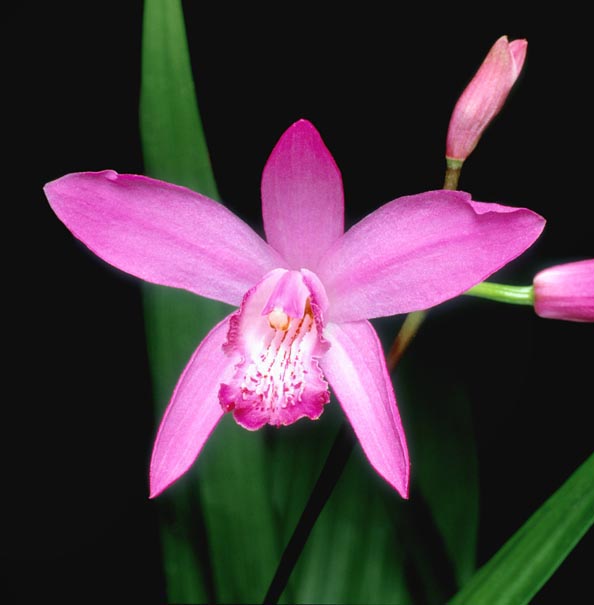Family : Orchidaceae

Text © Pietro Puccio

English translation by Mario Beltramini

Bletilla striata is an easy to cultivate terrestrial species bearing the cold © Giuseppe Mazza
This species is native to China (Anhui, Fujian, Gansu, Guangdong, Guangxi, Guizhou, Hubei, Hunan, Jiangsu, Jiangxi, Shaanxi, Sichuan and Zhejiang), Japan (Honshu, Kyushu, Ryukyu Islands and Shikoku) and Korea, where it grows at the borders of the evergreen forests of latifolious and of coniferous trees, in the meadows and in the cracks of the rocks, up to about 3000 m of altitude.
The name of the genus is the Latin diminutive of Bletia, genus of American orchids with which it has a remarkable resemblance; the Latin name of the species, “striata” = striated, refers to the grooves present on the labellum.
Common names: bletilla, Chinese ground orchid, hardy orchid, hyacinth bletilla, hyacinth orchid (English); bai ji (Chinese); jaran (Korean); orchidée jacinthe (French); shiran (Japanese); bletilla (Italian); bletilla, orquídeas urna (Spanish); Bletilla, Japanorchidee, Garten- orchidee, Chinaorchidee, Hyazinthenorchis (German).
The Bletilla striata (Thunb.) Rchb.f. (1878) is an herbaceous terrestrial species, cespitose, deciduous, with sub-globose underground pseudobulbs of 1 to 3 cm of diameter, erect stem tall up to 25 cm, enclosed below by imbricate sheaths, with 4-6 leaves from oblong to lanceolate, plicate, of a bright green colour, 8-40 cm long and 2-5 cm broad, with pointed apex.
Terminal inflorescences on a 12-30 cm long, erect, peduncle, racemose, carrying 3-10 flowers with oblong sepals with pointed apex, 1,5-3 cm long and about 0,5 cm broad, of mauve pink colour, petals similar to sepals, but broader, 0,5-1 cm, and tri-lobed labellum with purple venations, 1,5-3,5 cm long and 1-2 cm broad, with lateral erect lobes and median lobe with wrinkled margins, crossed from the base to the apex by 5 lamellae, waved in the terminal part; the column, slightly winged on the sides, is 1,5-2 cm long. A white flower variety does exist. It usually reproduces by division by the end of the resting time.
Spring-flowering species, it is considered as the easiest orchid to cultivate, suitable for an ample variety of climates, as it can bear in open ground, during the resting time, minimum temperatures up to -20 °C, provided well mulched; it is, in any case, to be protected from the late frosts when already vegetating.
It prefers a slightly shaded position and light and draining soils rich of organic substance, with the pseudobulbs placed at a depth of 3-5 cm.
It is cultivable also in pot in a substratum formed by garden earth, peat and sand in equal parts, to be placed outdoors and with regular waterings during the vegetative period, almost dry, but without never leaving it to dry up completely, during the resting time, when it is preferable to place the pot in a location where the temperature never goes below 0 °C.
The pseudobulbs are utilized in the traditional medicine, especially in the Chinese one, for various pathologies.
Synonyms: Limodorum striatum Thunb. (1784); Epidendrum striatum (Thunb.) Thunb. (1794); Cymbidium striatum (Thunb.) Sw. (1799); Cymbidium hyacinthinum Sm. (1805); Limodorum hyacinthinum (Sm.) Donn (1807); Gyas humilis Salisb. (1812); Bletia hyacinthina (Sm.) Aiton (1813); Jimensia nervosa Raf. (1838); Bletia gebina Lindl. (1847); Sobralia bletioides Brongn. ex Decne. (1847); Bletilla gebina (Lindl.) Rchb.f. (1853); Calanthe gebina (Lindl.) Lindl. (1855); Polytoma inodora Lour. ex B.A.Gomes (1868); Bletilla hyacinthina (Sm.) Rchb. f. (1878); Bletia striata (Thunb.) Druce (1917); Coelogyne elegantula Kraenzl. (1921); Jimensia striata (Thunb.) Garay & R.E.Schult. (1958); Bletilla elegantula (Kraenzl.) Garay & G.A.Romero (1998).
